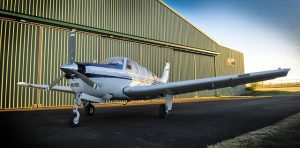
Do you know the difference between fuel-injected and carbureted aircraft engines? Whether it’s a small propeller-driven airplane or a wide-body commercial airliner, most airplanes today use one of these two types of engines. Both fuel-injected and carbureted engines burn a mixture of fuel and air in a combustion chamber, but they differ in several key ways.
What Is a Carbureted Engine?
A carbureted engine is characterized by the use of a fuel induction system known as a carburetor. Before entering the engine, fuel and air mix together in the carburetor. Once mixed, the fuel and air will travel to each of the engine’s cylinders, at which point a spark will ignite it. The highly combustible properties of this fuel-and-air mixture will create a controlled explosion that powers the engine.
What Is a Fuel-Injected Engine?
A fuel-injected engine is a type of combustion engine that shoots fuel directly into cylinders. It doesn’t have a carburetor. Instead, fuel is sprayed or “injected” directly into the cylinders. As the fuel mixes with air, it’s exposed to a spark that causes it to ignite.
In a fuel-injected engine, the fuel and air do not mix until they reach the cylinder. Since fuel injection systems shoot fuel directly into the cylinders, they are easier to flood (too much fuel) when starting
Differences Between Carbureted and Fuel-Injected Engines
The main difference between carbureted and fuel-injected engines is that the former uses a carburetor to mix the air and fuel before sending this mixture to the cylinders, whereas the latter does not. In fuel-injected engines, the fuel and air mix only mix together in the cylinders immediately before combustion occurs.
Fuel-injected engines are more likely to suffer from flooding than their carbureted counterparts. Pilots can control how much fuel is sprayed into the cylinders. If a pilot goes overboard with the fuel-injection system when starting the engine, he or she may flood it.
Another key difference between carbureted and fuel-injected engines is that the former is more likely to develop ice. Many crashes of carburetor-powered airplanes, in fact, have been attributed to the formation of ice. As fuel evaporates from the carburetor and the remaining air expands, the carburetor’s temperature may drop to below freezing. This is why most carburetor engines now have some type of heating system.
Carbureter heating systems are designed to melt any existing ice and prevent the formation of new ice. They typically work by rerouting air from the exhaust. This hot air will go to the carburetor where it melts and prevents ice from forming. Fuel-injected engines, on the other hand, don’t require a heating system.
Fuel-injected engines are more efficient than carbureted engines. With a carbureted engine, the fuel and air mix together in the carburetor before entering the cylinders. Therefore, they may run rich, meaning there’s too much fuel and too little air.



